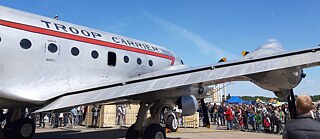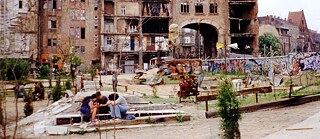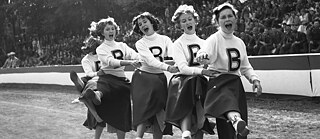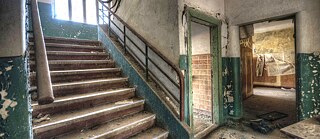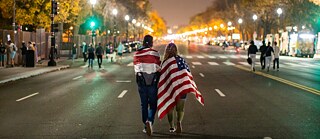Beispiellose internationale Hilfsaktion
Luftbrücke — 70 Years of Memories
Am 24. Juni 1948 kappte die sowjetische Militäradministration im Rahmen der Berlin-Blockade den Schienenverkehr und die Straßenverbindungen nach Westberlin und isolierte damit die Stadt vom restlichen Teil Westdeutschlands. Zeitzeug*innen erinnern sich.
Diese Folge anhören: Apple Music | Spotify | Download
Diese Folge stammt von den Berliner Radiomacherinnen Sylvia Cunningham, Monika Müller‑Kroll und Nikki Motson. Bei KCRW Berlin gestaltet das deutsch‑amerikanische Team ein englischsprachiges Programm für Zuhörer*innen aus der deutschen Hauptstadt. In diesem Podcast unterhalten sich Monika, Sylvia und Nikki mit dem berühmten US‑amerikanischen Piloten Colonel Gail S. Halvorsen, der auch als ‚Rosinenbomber‘ bekannt wurde; mit ehemalige Berliner ‚Kindern‘, die nun bereits mehr als 80 Jahre alt sind, und mit Bernd von Kostka vom Alliiertenmuseum. Als Musik ist in dieser Folge zu hören: „Midas Tongue“ von Sam Beam und Jesca Hoop, „Pears“ von Jonathan Kroll sowie „Berlin Ladies“ von Warner Poland und Wolfgang Glum (Monobeat Berlin), mit freundlicher Genehmigung der Künstler. Das Foto zur Folge stammt von Monika Müller‑Kroll und zeigt einen der historischen Rosinenbomberflieger am Berliner Flughafen Tempelhof. Außer dieser Episode haben Sylvia Cunningham und Monika Müller‑Kroll die Folgen „I Love You, I Hate You“ und „Little America Revisited“ aufgenommen, Monika produzierte mit Dina Elsayed zudem „The Diary“. Zwei dieser Podcasts stehen unter den Titeln „Das Tagebuch – The Diary“ und „Little America“ auch in deutscher Sprache zur Verfügung. Gemeinsam mit Nikki Motson produzierten Sylvia und Monika darüber hinaus die Folgen „Legacies of the Berlin Wall“ und „The Berlin Ringbahn“.
Transkript
[ON BOARD OF THE BUS TO TEMPELHOF FIELD]
Monika Müller-Kroll: It’s a sunny Sunday afternoon in Berlin. I am on the bus. Next stop, Tempelhofer Feld.
[GETTING OFF THE BUS]
Monika Müller-Kroll: Quite a few people get off. I am walking with Wolfgang, an 81-year-old Berliner. He is wearing a Michigan cap.
Wolfgang Loycke [IN GERMAN]: Ich bin in Berlin geboren. Und wir haben das alles hautnah erlebt.
Monika Müller-Kroll: We are heading to the Fest der Luftbrücke, the Berlin Airlift festival at the former Tempelhof Airport. A celebration of freedom and liberty, 70 years after the end of the Berlin Blockade.
Wolfgang Loycke [IN GERMAN]: Das war ja damals auch in der Zeit wie die Flugzeuge hier gelandet sind ...
Monika Müller-Kroll: Wolfgang tells me in those days in 1948, when the planes landed at Tempelhof Airport, there was a certain amount of anxiety. The Germans feared the allied pilots and the pilots feared the Germans. They had been enemies and now the Germans were servicing their aircrafts and friendships were developing. Wolfgang Loycke is one of over two million people who lived in West Berlin during the Soviet Blockade. The blockade was one of the first tests of the Cold War. And 2019 marks 70 years since the end of it. I’m Monika Müller-Kroll ...
Nikki Motson: ... I’m Nikki Motson ...
Sylvia Cunningham: ... and I’m Sylvia Cunningham. In this episode of the Big Pond, we learn about the Berlin Airlift from the people who lived through it.
Nikki Motson: It’s a story that brought hope to a struggling city in ruins, when West Berlin became isolated from the rest of West Germany, like an island floating 100 miles inside of Soviet-controlled East Germany.
Monika Müller-Kroll: It’s a story about bringing happiness to children coming of age at a time of war.
Sylvia Cunningham: It’s also a story of an amazing feat in history, creating firsts in aviation ... and a turning point between former enemies, who began working together in massive coordinated teams to save two million people from starvation.
Nikki Motson: This is the story of the Berlin Airlift.
[OUTSIDE THE ALLIED MUSEUM, WALKING UP THE STAIRS TO THE PLANE]
Sylvia Cunningham: At the Allied Museum in Berlin, I’m getting a history lesson from curator Bernd von Kostka. We’re headed inside an original British Hastings plane, parked outside the museum.
[BERND VON KOSTKA UNLOCKING THE DOOR]
Sylvia Cunningham: Alright, entering the plane — wow.
Bernd von Kostka: You can’t smell it, but we can! If you’re in here — still after 70 years — you can smell the old oil and the charm of an airplane from 1948.
Sylvia Cunningham: And what did this plane transport?
Bernd von Kostka: This was transporting cargo and as you can imagine, also this plane was used for transporting coal.
Sylvia Cunningham: In 1948, Berlin was a divided city. The East was controlled by the Soviets. The West was occupied by the Allied troops — with sectors for the French, the Brits, and the Americans. On June 24 — the western part of the city was officially cut off by the Soviets, and the Allied forces had a decision to make. Here’s archival footage from the United States Air Force.
Narrator from U.S. Air Force Audiovisual Presentation: Russia had been slamming the doors to the city — they cut road traffic, then rails, then barges. So America, Britain, and France decided to supply the city by air to keep freedom’s door open. Some experts called it an impossible task — more than two million Berliners prayed it wasn’t. Within a month, 159 U.S. aircraft were delivering 1,500 tons daily. It gave the people hope.
Sylvia Cunningham: Historian Bernd von Kostka says the Berlin Blockade was the first confrontation of the Cold War.
Bernd von Kostka: And this first confrontation was solved without guns, without the atomic weapon, without fighters in the air. It was solved by logistics, it was solved by flying lorries.
Sylvia Cunningham: West Berlin authorities made lists of what the city needed, and it was up to the combined airlift task force to sort out the logistics: how they would distribute thousands of tons of vital supplies like coal and food into the city every day.
Bernd von Kostka: And keep in mind — everything was done without computers, without mobiles. All those calculations, everything that’s very essential for us nowadays, was done all by hand — manual. I’ve seen people on huge lists ... they needed ladders to keep those lists updated, because those lists were so long.
Sylvia Cunningham: Really?
Bernd von Kostka: Yeah.
Sylvia Cunningham: During the Berlin Airlift, the Allies worked out of three airports. Tempelhof, West Berlin’s main airport in the American sector, Tegel in the French sector, and Gatow in the British sector. The operation reached its peak in April 1949, when nearly 1,400 flights landed in 24 hours. That’s roughly one airplane every 62 seconds, a rate von Kostka says even today some airports in major cities don’t reach.
And where was this plane in 1997, before it landed in the Allied Museum?
Bernd von Kostka: Oh it was the gate guard of the Royal Air Force in Gatow in Berlin. And when in 1994, the three Allied powers withdraw from Berlin, they closed the British military airport in Gatow and they handed over this plane as a present to the Allied Museum, and we were glad to receive this present, but then we discovered the problems to get it from Gatow to the Allied Museum. And finally we had to chop off the wings and had to hire the biggest transport helicopter in the world, which is ironically a Russian ME206 (plane) coming from Kiev to transport the symbol of the Allied Airlift into the Allied Museum.
Sylvia Cunningham: Wow.
The Allied Museum’s permanent exhibition pays tribute to the heroes of the Berlin Airlift, preserving their personal photos and trinkets from the city where they left their mark.
[TRUMPET MUSIC PERFORMED LIVE BY MEMBER OF THE STABSMUSIKKORPS DER BUNDESWEHR DURING 70TH ANNIVERSARY CEREMONY ON MAY 12, 2019]
Monika Müller-Kroll: On May 12, 2019, a ceremony at the Platz der Luftbrücke remembered the people who lost their lives during the Berlin Airlift. Beyond the Allied troops, Australia, Canada, New Zealand, and South Africa were involved in the effort. Veterans and their families came to Berlin for a weekend of commemorative events.
What’s your name?
David Carsey: David Carsey.
Monika Müller-Kroll: And you were part of the airlift 70 years ago.
David Carsey: Yes, 70 years ago. Yeah.
Monika Müller-Kroll: What are your memories, or what do you remember most?
David Carsey: Oh, working hard, busy. I was in the control tower at Gatow working on a Mosky taking and receiving messages. I was 18, I think — 19, 18 then.
Monika Müller-Kroll: You were very, very young then. Wow!
David Carsey: But, ah. We enjoyed it ...
Monika Müller-Kroll: You knew you were part of something very special.
David Carsey: Yes, it was worthwhile.
Monika Müller-Kroll: Is this your daughter?
David Carsey: Yes, it’s my daughter.
Evelyn Carsey: We are very honored to be here, it’s an absolutely fabulous time we are having.
Monika Müller-Kroll: Are you proud of your father?
Evelyn Carsey: Very much so. Absolutely. He just had his 90th birthday.
[“GOD SAVE THE QUEEN” PERFORMED BY THE STABSMUSIKKORPS DER BUNDESWEHR DURING 70TH ANNIVERSARY CEREMONY ON MAY 12, 2019]
Sylvia Cunningham: Can you say your name?
Alan Jeeves: Alan Jeeves. Jeeves.
Sylvia Cunningham: And so you were involved in the Berlin Airlift?
Alan Jeeves: Gatow.
Sylvia Cunningham: Gatow, OK.
Alan Jeeves: I was 18 at the time, yeah.
Julie Jeeves: And he’s 90 now.
Alan Jeeves: Yeah.
Julie Jeeves: I’m going to get him to write it all down. I don’t think people like myself were really aware of what these people did ... because they don’t talk about it very much at home. It’s just something that they did. And then for me to be here now and go through this with my father-in-law ... it’s just incredible. And you know, I just admire them all so much now. I have a greater understanding of what actually took place. And I want to keep that going, you know, because we’ve got a granddaughter now, and I want her to know about her great granddad now. And things like that. Just carry on. Because it’s just amazing. Amazing.
[FOOTSTEPS AND APPLAUSE]
Sylvia Cunningham: At the ceremony, there was a special guest of honor. A 98-year-old American pilot. His sweet spontaneous act of kindness during the airlift captured the hearts and attention of people worldwide.
Gail Halvorsen: We are grateful to be here. God bless you. I’m honored to be a son of Berlin. And Berlin ist meine zweite Heimat. Danke!
Nikki Motson: He received a standing ovation from the crowd after his remarks, and I had the chance to speak with him here in Berlin.
Gail Halvorsen: I’m Gail S. Halvorsen, the Berlin Candy Bomber.
Nikki Motson: As a young pilot, it wasn’t easy for Colonel Halvorsen to come to Berlin. Like many others, he had lost people dear to him during the war.
Gail Halvorsen: I taught one of my best friends to fly before the war, during the Army Air Corps, sent to bomb Berlin, and they killed him. I always felt that I had a hand in that because I got him started flying.
Nikki Motson: Despite those feelings of animosity and regret, Halvorsen signed up to join the airlift. The people of West Berlin were starving. He remembers the shock he felt when he flew over Berlin for his first airlift delivery.
Gail Halvorsen: And I just couldn’t get over it ... from the air it just looked like a moonscape down there. Almost all the buildings had damage. Roofs — empty. Roofs up to the sky. I had flown during the war of course, and seen different places, but for a city to be bomb marked all over the streets. Houses ripped apart, still, at that time. So it was an eye opener for me to see how the city was almost destroyed, but rightfully so, because of the things Hitler had done. So it’s not a very happy time. War is not a ... it affects people whether they’re on the front lines or at home and they’re a bombing target.
Nikki Motson: Devastation all throughout Berlin wasn’t the only thing he noticed. At Tempelhof airfield, German children flocked to the fence to watch the planes landing. They were curious and polite. Some even thanked the pilots in their broken English. They didn’t ask for anything. Halvorsen reached into his pocket and gave them the only two sticks of gum he had. And then he watched. There must have been about 30 children at the fence, he recalls, but they didn’t fight. They just happily split the gum into smaller and smaller bits and passed them around, and when that wasn’t enough — they passed the wrapper around. So that each child could enjoy the scent.
Gail Halvorsen: The kids were all over the place and waving to me and just being vanquished by a terrible war and Russians were a bigger threat than anything. And they want to stay free. The desire for freedom is so universal in the human spirit, and those kids didn’t want anything to do with the Soviet system. So we had a real purpose to see that they got enough to eat by air alone. And I enjoyed it. It was incredible to be part of that.
Nikki Motson: And how did you feel the first time you waggled your wings and dropped parachutes with candy in them and saw the kids running after them?
Gail Halvorsen: Well it was about 3 or 4 days after I met them at the fence and I told them that’s what I’d do. They said “How will we know which airplane to watch? We gotta know which one to watch.” And I said, “I’ll wiggle the wings. Watch the airplanes on the approach. When you see one wiggle the wings, that’s me — get ready for it!” And they said, “That’s a good idea, let’s get started.” So they were all for it. And I bought enough chocolate and gum, it was rationed, so I bought all I could, got my buddies to buy some, and came back the next day and it was clear, and I came over the field and wiggled my wings, and those kids went crazy! Watched me every step of the way. Well they didn’t have any candy, you know. They didn’t have anything like that.
Nikki Motson: Such a luxury item post-war.
Gail Halvorsen: Yeah, and then to see it come out of an airplane ...
Nikki Motson: I bet word spread quickly!
Gail Halvorsen: Yeah, it did. Kids would line up on the approach to the airport, waving like mad, so we did it again and again.
Nikki Motson: Christel Jonge Vos was one of those kids who went to Tempelhof to watch the Berlin Airlift planes coming in. She was 11 years old at the time. We reached her at her home in Oregon.
Christel Jonge Vos: We had heard about the Schokoladenbomber, the chocolate bomber, wiggly wings, and sure enough — we were able to see Gail Halvorsen wiggling his wings and dropping little parachutes with chocolates. I never caught one — the boys were always faster — but this was of no importance to us. Important was that, at that time, there was someone who cared.
Nikki Motson: That someone cared. It’s a sentiment that many of the children who lived in postwar Berlin remember feeling because of the airlift. Like Roswitha Barry who was 7 years old.
Roswitha Barry: You know, it wasn’t just a candy bombings. It was that the Americans were there to save us. And the British and the French and of course other allies had helped. But it wasn’t until then that we felt that we have a chance. Because we grew up in ruins. It’s sad to think about it because even so, at that time, I didn’t know any different. And it was fun. But when I look at it now, and I see the films, and I say ... how did I ever survive that?
Gail Halvorsen: To see those kids who didn’t have anything and out of the sky came a whole ton of chocolate bars on little parachutes, it was a thrill. And the letters started coming immediately. And they said well, we didn’t participate in the war but we had to be here. My aunts and uncles and dad and mom were all involved in the war effort, but I’m glad that you help us kids now afterwards. It wasn’t their fault what happened.
Nikki Motson: Absolutely not.
Gail Halvorsen: So there were thank you letters.
Nikki Motson: Like a little ray of hope as well.
Gail Halvorsen: And maps, maps. Most all of them drew maps. Germans kids can draw great maps. “When you come down the street, so and so, turn right two blocks, I live on the corner, I’ll be in the backyard, every day at two o’clock. Drop it there.” And I tried to do it! Of course with that many flight operations you couldn’t deviate too much.
Nikki Motson: It was quite an operation. Every few minutes.
Gail Halvorsen: Oh, yeah. Unbelievable. Unbelievable. But it was worth it. The appreciation. Appreciation is a factor that can change lives.
Roswitha Barry: Of course the chocolates for children is always great. But it was more for us that they were there to save us, because we understood as young as we were, that we wanted our freedom and to have that we needed the allies to do it for us even so Germany had lost the war. But I met one of the pilots, 8 years ago, in Ogden, Utah and us Berlin kids surprised the veterans at their yearly meeting. And they couldn’t believe it because there we stood with the Berlin flag and the Hershey’s bars, and they said, “First we bombed them and then we fed them.” And they said it was easier to feed them than bomb them. And they never realized, never thought in their lifetime that they would meet the children that they saved. And so the airlift veterans are very, very special to us. And we make sure that we always do something for them.
Vera Mitschrich: My name is Vera Ella Mitschrich. From Hermsdorf-Frohnau. I can remember very good. I was just 5 years, 6 years old. But it was just amazing. I lived in the American sector — Friedenau, in Steglitz where all the Americans are coming. And then Gail come, with the aircraft. You know, he makes this ...
Nikki Motson: Wiggling the wings?
Vera Mitschrich: Wiggling, and the candies are coming. And I love Hershey’s chocolate. And it’s so great. And I’m very thankful. And my mom — she was also very happy and she let me know. And she said to me, “Vera.” She had a vision. “Vera, maybe one day, you can say thank you.” And now I can. I’m so proud of you all. I’m so thankful. And I must stop and God bless you all. Vera from Berlin, Germany. I’m so proud of you all. Thank you.
Monika Müller-Kroll: To this day, the Berlin Airlift is considered one of the world’s greatest humanitarian efforts, but it wasn’t without sacrifice. At least 78 military personnel and civilians died in the effort.
Sylvia Cunningham: On May 12, 1949, the Soviets lifted the blockade and allowed supplies to begin flowing again into West Berlin.
Nikki Motson: The storytellers of the Berlin Airlift are becoming fewer and fewer, but there’s a message that carries on. As Colonel Halvorsen often says, from small things can come something great. For THE BIG POND, I’m Nikki Motson.
Sylvia Cunningham: ... I’m Sylvia Cunningham ...
Monika Müller-Kroll: ... and I’m Monika Müller-Kroll.



